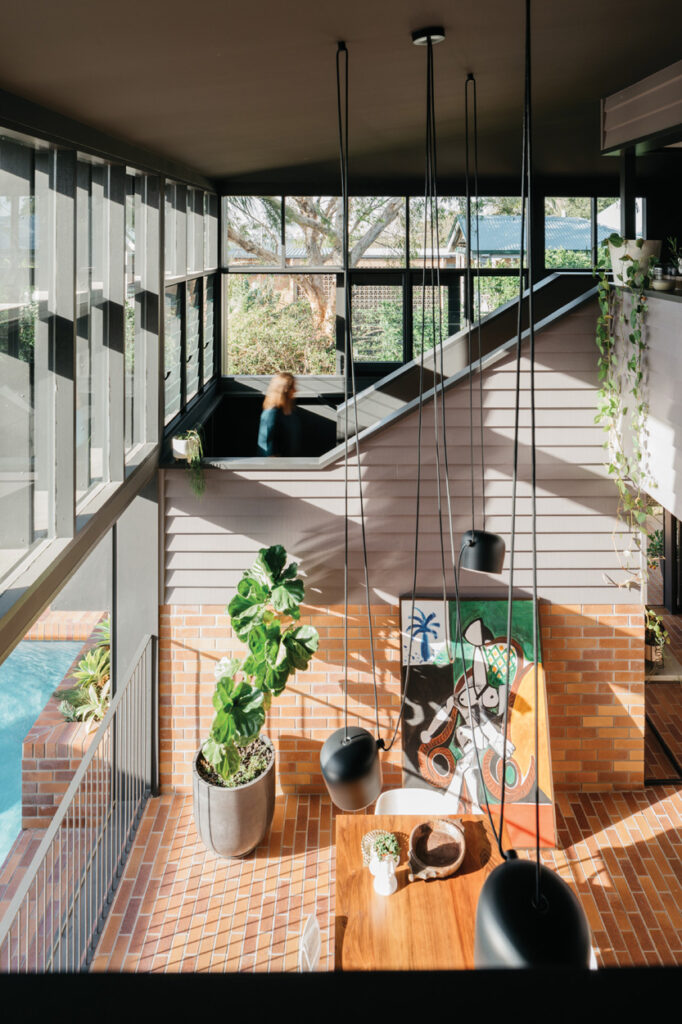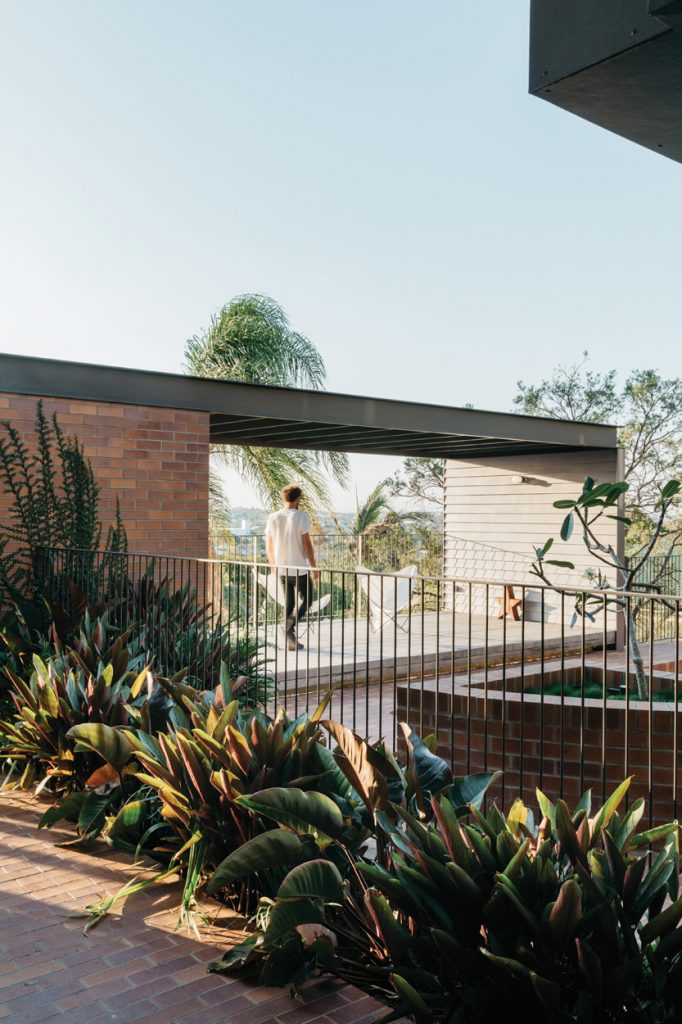Challenge Accepted
A challengingly-oriented site proved no match for NIELSEN JENKINS, who created a contemporary place of refuge that celebrates daily happenings.
The western sun can be brutal in the subtropics. For the summer months particularly, the intensity of heat and glare that besieges the late afternoon is unbearable until sunset. Relief comes when the last rays are extinguished and the cooling north-easterlies draw residual heat from the day. But like anything in life, reward comes with sacrifice and locals have come to appreciate that embracing the western aspect means participating in the most extraordinary time of day.
On a west-facing ridge in the Brisbane suburb of Wooloowin, elevation and aspect make the spectacle of sunset something of the central focus. When Simon and Rachael and their children, Hugo and Lulu and pup, Rocky, moved in a few years ago, the original Queenslander was in good condition but the undercroft, which transitioned onto pool and garden, was uninhabitable as degrading foundations threatened to detach it from the hillside. Charged with devising new alterations and additions, architects Lachlan Nielsen and Morgan Jenkins overcame issues of slope and sun to create a place of refuge from the heat and reprise for the spectacle of sundown.
One controversial move was all it took to unlock the relationship of house proper and contemporary undercroft; the demolition of the back deck. Family members were incensed by the idea but carving a hole in the floor released a double storey volume below the existing roof where new social spaces could be grounded in earth. Kitchen and dining areas settled naturally into the void and from here a string of outdoor spaces, incrementally becoming more engaged with the garden and horizon, were planted. Abutting the house, a pool and garden were reinstated, open to sky and surrounding these came two sheltered outdoor wings, a paved cloister running along the southern boundary and at right-angles to this, a raised deck enclosing the pool.
By embracing a “dynamic plan” the pressure placed on the brise soleil to remove all sunlight from the western elevation was relieved. “We knew we couldn’t beat the west entirely,” Simon says. “For two hours of the day it’s hot but as evening approaches it’s just magical. We knew we just had to negotiate that period of time.” The two-storey southern wall, combining both masonry and steel mesh, establishes a defensive shield to neighbouring flats while making a place of refuge from the ensuing rays. “We wanted to provide options, allowing everyone to move around the plan to escape the heat,” Morgan says.
Daily patterns of movement are largely dictated by seasonal sun angles and fluid occupation of the U-shaped ground floor. Mornings begin in the convivial space between kitchen and dining room and as the day progresses, the exchange intensifies at the centre of the plan around the swimming pool and garden. As the sun migrates into the western sky and begins its descent over the distant Taylor Range, the party takes shelter in the bunker of the southern wall. “This is [the] most private and most shaded part of the house,” Morgan says. “You can tuck in around here until the heat comes out of the sun.”
Of all the carefully scaled and finished spaces of the ground floor, it is this outdoor laneway nestled along the southern boundary that fulfils the aims of the project to celebrate “both gathering and retreat”. The scale of the space, while largely dictated by the width of the site, fosters a sense of intimacy that complements the more generous spaces of the interior. The vertical volume, punctuated by pot plants supported by integrated steel plates, is akin to a small laneway and immediately encourages groups to stand closely in conversation. Moments of program activate this long edge and a robust material expression supports its resilience to wear.
“Simon was really keen on outdoor cooking and his Grillworks was a big part of that,” Lachlan says. “The family wanted to cook outside and get in and out of the pool and grab a beer and not worry about oil or water or being precious. We were interested in one material that could cope with that. The brick, I think, has been really successful in managing all those things.”
With the transition to evening comes the final migration to the timber deck. At this place, closest to the horizon and furthest from the house, Simon and Rachael take pause to reflect on their day and time to appreciate the decisive moves that have brought big changes to their household. “A lot of houses with views are very directional but our brief was that we wanted to have some introspection,” Simon says. “Our favourite spot is the deck, where we watch the setting sun. Once the sun has set we turn around and look into the house. It’s with this perspective we can appreciate all the hard work we have done to get here.”
Specs
Architect
NIELSEN JENKINS
nielsenjenkins.com
Builder
PJL Projects
Passive energy design
The original house opened up predominantly to the east and west, so new openings are located on the northern and southern edges to pull prevailing breezes through the plan. Louvres are used in combination with the larger sliding openings so the house can breathe securely during the day and night. A large void allows natural daylight deep in to the downstairs plan from the west but also the northern edge. Inside the existing house, new walls upstairs are lowered to the picture rail height with timber battens above to allow light and cross ventilation. Externally, a series of shading devices are used to provide relief from the brutal western sun. A new double-height metal mesh arbour diffuses the south-west summer sun, and a new timber arbour to the western edge provides shade for the pool. At the building’s edge a new fibre cement and steel framed window hood provides relief for the glazing behind.
Materials
The owners of the Wooloowin House are restauranteurs and one of the primary focuses of the project was to provide them with robust and memorable entertaining spaces that cope with the severity of the western sun which falls deep in to the plan. Materials were selected to minimise maintenance and allow continuity between the internal and external areas. Generally, materials that are grounded are masonry (brick and concrete) and then elevated components become lightweight (timber and steel mesh) to create a clarity to the parts of the project that touch the ground and the parts which float above the contour. The existing slab was reused downstairs so solid bricks were cut into tiles to maintain head heights and to maintain continuity with the outside areas. All new walls are of highly insulated, lightweight, mainly timber-framed construction. The interiors feature VJ sheeting and all paints are low-VOC. A Danish oil finish is used for all timber bedroom, kitchen and bathroom joinery. In situ concrete is used for the island bench with a penetrating sealer.
Flooring
Upstairs, existing flooring was retained and then the small rectification works were made with blackbutt. Downstairs, solid bricks were used so that two faces could be used of every brick for tiling. These same black and tan bricks were used for the external flooring and pool coping.
Glazing
Windows are timber-framed and painted, with Viridian low-E clear glazing and Breezway louvre inserts windows.
Heating and cooling
By moving the living areas of the house downstairs, the thermal mass of the building is used during the day to stabilise temperature. In the evenings, this heat gain dissipates very quickly with the amount of operable edges in the downstairs plan and cools very quickly. Similarly, in winter the thermal mass heats up during the afternoon and then can be kept inside with the doors closed. Louvres are used to provide secure ventilation at night-time or when the occupants are at work.
Hot water system
Hot water is provided by a gas hot water split system.
Lighting
The house uses low-energy LED lighting and feature lights from Flos.












